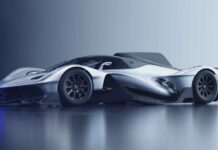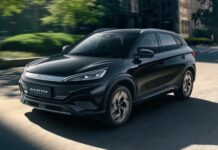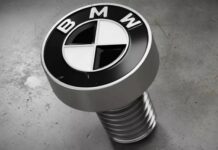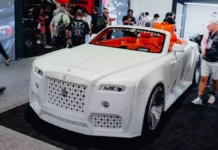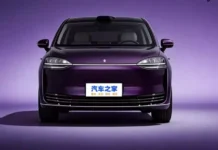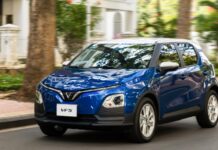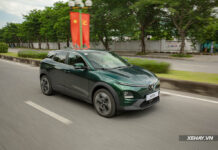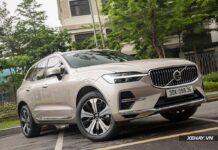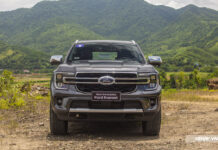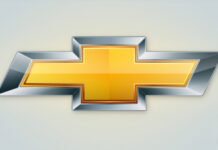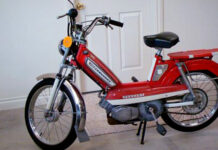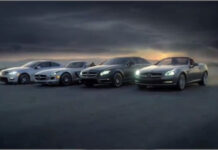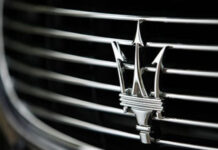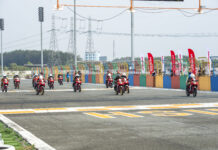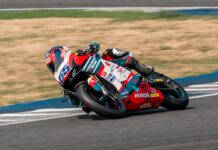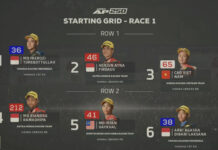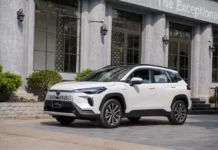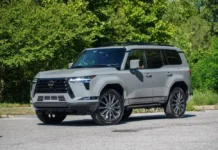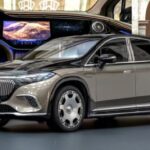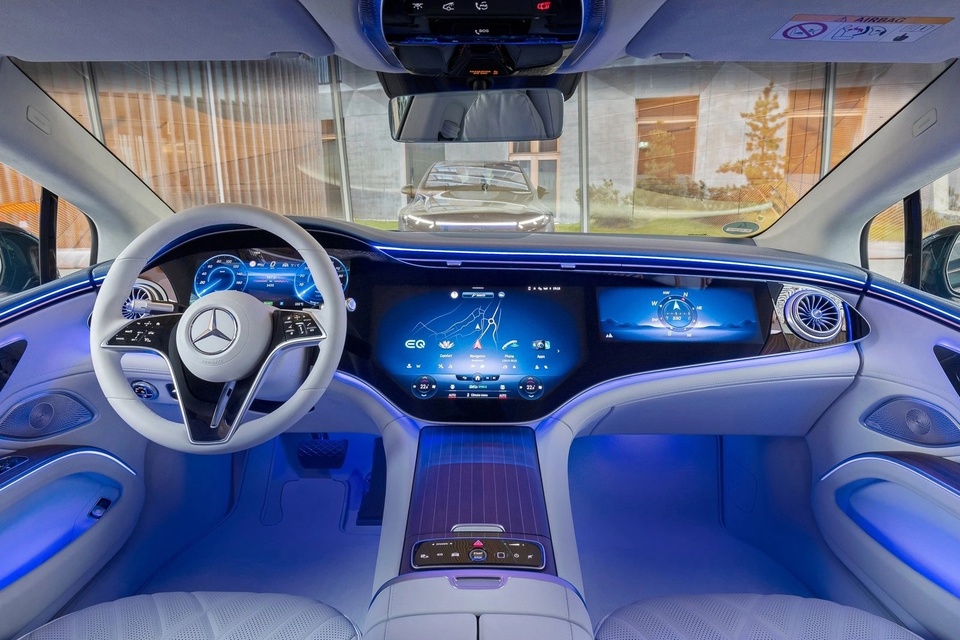
|
In 2021, Mercedes-Benz introduced a groundbreaking technology with the launch of its expansive dashboard screen, marking a departure from traditional physical buttons.
Dubbed the MBUX Hyperscreen, this innovative feature made its debut in the EQS electric sedan, comprising three seamlessly connected screens measuring 12.3 inches, 17.7 inches, and 12.3 inches, respectively, encased in a sleek glass panel.
The MBUX Hyperscreen initially garnered attention as a standout feature in the EQS sedan, and subsequently found its way into the EQS SUV, EQE, and most recently, the S-Class, as part of its upcoming update.
The Race to Bigger Screens
Despite the impressive size of the Hyperscreen at its launch, Mercedes-Benz expressed ambitions to further expand it, eliminating the “dead space” around the air vents near the doors.
In January 2024, Mercedes-Benz CTO Markus Schäfer revealed to Autocar that the company was exploring the integration of additional screens in their vehicles.
“Mercedes will aim for a seamless screen from left to right across the dashboard. This will be the next evolution,” shared Mr. Schäfer.
| |
|
Mercedes once intended to add more screens to the Hyperscreen array. Image: Mercedes. |
The CTO teased a “truly amazing experience” from the large OLED screen, boasting a width of over 55 inches, roughly equivalent to 1.4 meters.
Mercedes also aimed to lead the market in graphics performance, leveraging gaming engine technology as the foundation for their screens.
The introduction of the Hyperscreen sparked a trend in the automotive industry, prompting car manufacturers to hastily incorporate larger screens into their vehicles.
For instance, BMW equipped its 7-Series and 5-Series long-wheelbase models in the Chinese market with a massive 31.3-inch, 8K-resolution screen that could be retracted into the ceiling. The rear doors of these vehicles also featured 5.5-inch touchscreens, allowing passengers to access various vehicle functions.
|
BMW and Audi join the race to incorporate larger screens in their vehicles. Images: BMW, Motor1. |
Audi unveiled the Grandsphere concept, showcasing a sweeping curved screen that spanned the entire dashboard. The concept vehicle also included a small speedometer screen behind the steering wheel, providing essential information to the driver during operation.
The trend toward larger screens also made its way to the Chinese automotive industry. The Aito M9 SUV boasts a Hyperscreen-like array, featuring a 12.3-inch digital instrument cluster, a 15.6-inch central infotainment screen, and another 16-inch screen next to it on the passenger side.
| |
|
The Aito M9 also features a large screen array that dominates the dashboard. Image: Aito. |
Additionally, the Aito M9 is equipped with a 75-inch HUD, a 32-inch retractable ceiling screen, and four smaller screens for rear passengers.
Mercedes’ Conundrum
Despite being at the forefront of the large-screen trend, Mercedes-Benz has recently exhibited some confusion in its interior design direction.
In a recent interview with ABC News, Gorden Wagener, Chief Design Officer of the Mercedes-Benz Group, opined that “screens are not the definition of luxury.”
| |
|
Mercedes’ Chief Design Officer believes that screens do not define luxury. Illustrative image: Mercedes. |
The head of design for the company that introduced the Hyperscreen now suggests that as screens become ubiquitous in vehicles, cramming more screens into the dashboard is no longer a novel concept.
After a prolonged pursuit of larger screens, Mercedes seems to have realized that the Hyperscreen may not play a significant role in their efforts to define luxury and opulence in automobiles.
The inclusion of a large touchscreen, as seen in the Hyperscreen, effectively eliminates most physical buttons from the dashboard. According to Motor1, this trend undermines the potential for beautifully crafted, intricate physical buttons in premium vehicles.
| |
|
Touchscreen operations can lead to driver distraction. Illustrative image: Mercedes. |
Additionally, performing most vehicle functions through touchscreens instead of physical buttons can impact the driver’s focus. The accumulation of fingerprint smudges on large screens, as noted by Motor1, may also detract from the overall luxurious feel of the vehicle.
When it was first introduced, the Hyperscreen was an expensive option. Customers purchasing the EQS electric sedan for £100,000 (approximately $125,900) could add the MBUX Hyperscreen for an additional £7,995 (around $10,065).
Do Cars Need Large Screens?
Jake Groves of Car Magazine shared his personal experience, noting that the standard MBUX system in Mercedes vehicles, with its vertical screen, already covers about 90% of what the Hyperscreen can do.
Groves concluded that the Hyperscreen might be a bit excessive but encouraged interested buyers to go for it if they are tech enthusiasts.
An article on Mercedes Blog deemed the upgrade to the Hyperscreen as not worth the money, while Car Freak was also not impressed with Mercedes’ large dashboard screen design.
Despite these opinions, the Hyperscreen remains an impressive feature from the German automaker and is likely to be retained in future Mercedes electric vehicles.
Since 2024, the MBUX Hyperscreen has only been available as a standard feature in the latest EQ electric vehicles, and customers cannot add it as an extra option as they could in the past.
| |
|
The Mercedes-Benz EQE Sedan showcases the MBUX Hyperscreen in its cockpit. Image: Mercedes. |
Currently, the trend of incorporating large screens remains popular among Chinese automakers. For instance, the Galaxy E8 electric sedan, launched in January 2024, features a massive 45-inch, 8K-resolution screen behind the steering wheel, occupying almost the entire width of the dashboard.
BYD electric vehicles are known for their large central screens, which can be rotated between portrait and landscape orientations. The GAC Trumpchi E9 MPV features three screens of different sizes arranged in a non-continuous layout on the dashboard, including a 12.3-inch digital instrument cluster, a 14.6-inch central infotainment screen, and a 12.3-inch screen on the passenger side.
The Lynk & Co 900 SUV, on the other hand, boasts a 30-inch, 6K-resolution screen that sits proudly above the dashboard, starting from the center and extending toward the passenger side.
The rear of the central console in this SUV features an additional small screen. On the ceiling, there is another 30-inch, 6K-resolution screen for rear passengers.
|
The GAC Trumpchi E9 (left) and Lynk & Co 900 (right) showcase impressive screen arrays in their cockpits. Images: GAC, Lynk & Co. |
In summary, equipping vehicles with large screens or cramming multiple screens into the dashboard is not necessarily the definition of luxury and opulence, as rightly pointed out by the Chief Design Officer of the Mercedes-Benz Group.
Instead, as automobiles evolve to become more modern and people-centric, incorporating multiple screens primarily serves as a showcase of technology, ensuring entertainment and enhancing the overall experience for passengers, rather than being a defining factor of luxury.
Even Mercedes’ Chief Design Officer, Gorden Wagener, acknowledged that the company is working on improving the quality of content displayed on the large Hyperscreen array, aiming for more specific and entertaining offerings for passengers.
Recommended Reads for Your Journey
Our Vehicles section offers a diverse range of engaging book titles to accompany you on your travels. Whether you’re embarking on a road trip or enjoying a quiet moment in your vehicle, these books are sure to enrich your journey.
2024 Mercedes-Maybach EQS 680: Dominant 649 HP, 600 Km Range per Charge.
Maybach’s debut into the electric vehicle market comes in the form of the impressive Mercedes-Maybach EQS 680 2024. This luxurious car embodies power and speed, boasting an astonishing acceleration from 0-100 km/h in a mere 4.4 seconds. What makes this electric masterpiece even more unique is the fact that it is manufactured in the United States, bringing a touch of American craftsmanship to the renowned German brand.

